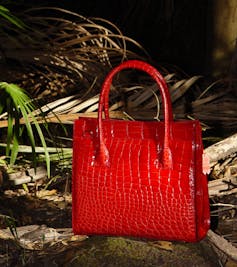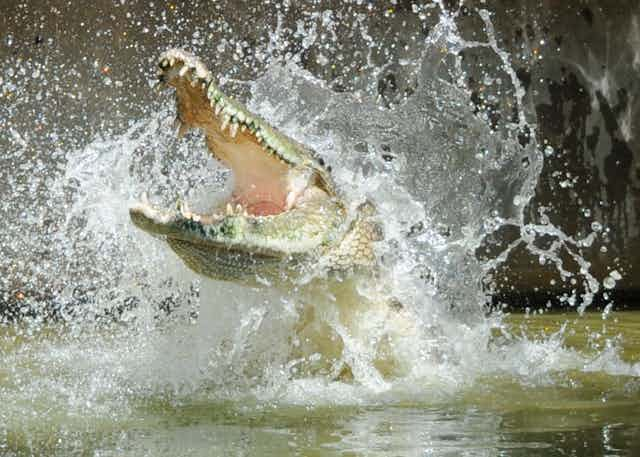There have been two fatal saltwater crocodile attacks on people in the Northern Territory (NT) in the last four weeks. Calls to “cull” the wild population of crocodiles have inevitably surfaced. More school children in the NT will be assigned projects aimed at assessing the arguments for and against culling. More tourists will learn about the NT through the media, and in a macabre twist, there will be an increase in tourist bookings.
There is no way of avoiding nor sugarcoating the predatory nature of saltwater crocodiles. If you dive off the Adelaide River bridge, 60 km east of Darwin’s city centre, and start swimming, there is 100% chance of being taken by a saltwater crocodile. It is not the same as swimming with sharks.
The central problem is that there are now a lot of crocodiles in the NT, and for many people the solution to the problem of crocodile attacks lies in reducing the number of crocodiles by culling. But it is not so simple.
For over four decades the crocodile population in the NT has been increasing, crocodile attacks have been occurring, and calls for culling have been raised. But politicians in the NT, where most crocodiles in northern Australia live, have not authorised a widespread cull.
Residents in the NT generally support that decision - although sometimes begrudgingly. Their decision has little to do with ecology, biology, Archesorial ancestry or the intrinsic value of crocodiles, which people such as myself hold dearly. It is because the public and politicians accept that the benefits of abundant saltwater crocodiles ultimately outweigh the costs.
Conserving wildlife that prey on people is one of the world’s great challenges. Most predators were historically eradicated as pests; if they had a valuable skin, well all the more reason to rid the world of them.

It was only as biological extinction loomed - the risk of losing the last one - that the net values changed. Positive values were attributed to avoiding extinction, and because attacks were rare or non-existent due to population depletion, the negative values had essentially disappeared.
But where predator conservation action is successful, the threat of extinction dissipates (along with the positive values attributed to overcoming it), and the negative values escalate as more and more attacks occur. Calls for action (culling) escalate and a political problem emerges. People have always seen themselves as having rights to be protected from marauding wild animals.
In the NT, depleted saltwater crocodile populations were protected in 1971. Since then the wild population has expanded some 20 times in abundance and 100 times in biomass. The role of competing “values” in paving the way for that recovery was recognised in the early 1980s and remains central to their management today.
Commercial use based on both ranching (collecting and selling wild eggs), and limited direct wild harvesting, is clearly biologically sustainable and allows landowners to benefit financially from the increasing number of crocodiles on their lands.
Crocodile farming, based largely on ranching (collecting and selling wild eggs), generates some $25 million per year in skin sales for the international high fashion industry and has extensive commercial flow-on effects in the community. Tourism, based on wild and captive crocodiles, is the mainstay of the “Top End” tourist industry.
Tourism is everyone’s business in the NT. It is the second largest industry and biggest employer of people. National and international documentaries and media attention on the NT’s successful crocodile management program is arguably the primary vehicle through which Top End tourism is promoted against competing destinations.
Against these positive values, associated with having abundant crocodiles, a refined public education program ensures residents and visitors are well-informed about “crocodile safety”. An active problem crocodile program is dedicated to trying to keep crocodiles extinct in Darwin Harbour, where most people live, and to removing individual crocodiles that cause problems in remote communities – thereby reducing negative values.
So there are areas in the NT where abundant crocodiles are favoured and appreciated, and areas where they are not. It is not a perfect system, but it has worked remarkably well. Widespread culling, with the general goal of reducing the total population in all areas, has not been implemented because it would come at a cost to those benefiting from having abundant crocodiles in most areas.

Issues like “trophy hunting” are not about improving public safety, but rather about finding more ways in which landowners can gain more commercial returns from killing the same crocodile than they can do now to sell its skin.
Steadily improving the problem crocodile program, especially in Darwin Harbour, involves strategic culling at a level that does improve public safety – taking out every crocodile possible. A strong case may be made for eradicating saltwater crocodiles that move well-upstream, out of core areas, and become established in new areas from which they have not been known historically - an increasing risk to people.
Such management decisions, in the case of the NT, need to be made in the context of risk assessment within the NT. Pragmatism with crocodile management is a critical ingredient.
The idea that culling the wild population as a whole would help public safety may be true if the cull was very severe, and aimed at bringing the population back to the pre-protection levels. However, if the population was reduced by say one half: “which politician would say it is now safe to go back into the water?”.
It clearly would not be safe. Is it safer to see abundant crocodiles in a wetland, where swimming would not even be considered, or be lulled into a false sense of security by having a lesser number of more wary crocodiles?
Then there is the response to culling. It could stimulate an increase in the wild population, as occurred with caimans in Venezuela. It is crocodiles that are controlling the size of the wild crocodile population, and if the larger ones are selectively removed, the population could be expected to expand.
In any overview, selective culling has a role to play in the overall management of crocodiles, but is not the public safety panacea that it may superficially appear to be.

